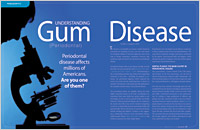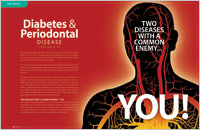 Periodontal disease is diagnosed by your dentist or dental hygienist during a periodontal examination. This type of exam should always be part of your regular dental check-up.
Periodontal disease is diagnosed by your dentist or dental hygienist during a periodontal examination. This type of exam should always be part of your regular dental check-up.
A periodontal probe (small dental instrument)
is gently used to measure the sulcus (pocket or space) between the tooth
and the gums. The depth of a healthy sulcus measures three millimeters
or less and does not bleed. The periodontal probe helps indicate if
pockets are deeper than three millimeters. As periodontal disease
progresses, the pockets usually get deeper.
Your dentist or hygienist will use pocket
depths, amount of bleeding, inflammation, tooth mobility, etc., to make a
diagnosis that will fall into a category below:
Gingivitis is the first stage of periodontal
disease. Plaque and its toxin by-products irritate the gums, making
them tender, inflamed, and likely to bleed.
Plaque hardens into calculus (tartar). As
calculus and plaque continue to build up, the gums begin to recede from
the teeth. Deeper pockets form between the gums and teeth and become
filled with bacteria and pus. The gums become very irritated, inflamed,
and bleed easily. Slight to moderate bone loss may be present.
The teeth lose more support as the gums, bone,
and periodontal ligament continue to be destroyed. Unless treated, the
affected teeth will become very loose and may be lost. Generalized
moderate to severe bone loss may be present.
Treatment
Periodontal treatment methods depend upon the
type and severity of the disease. Your dentist and dental hygienist
will evaluate for periodontal disease and recommend the appropriate
treatment.
Periodontal disease progresses as the sulcus
(pocket or space) between the tooth and gums gets filled with bacteria,
plaque, and tartar, causing irritation to the surrounding tissues. When
these irritants remain in the pocket space, they can cause damage to
the gums and eventually, the bone that supports the teeth!
If the disease is caught in the early stages of gingivitis,
and no damage has been done, one to two regular cleanings will be
recommended. You will also be given instructions on improving your
daily oral hygiene habits and having regular dental cleanings.
If the disease has progressed to more advanced stages, a special periodontal cleaning called scaling and root planing (deep cleaning)
will be recommended. It is usually done one quadrant of the mouth at a
time while the area is numb. In this procedure, tartar, plaque, and
toxins are removed from above and below the gum line (scaling) and rough spots on root surfaces are made smooth (planing).
This procedure helps gum tissue to heal and pockets to shrink.
Medications, special medicated mouth rinses, and an electric tooth brush
may be recommended to help control infection and healing.
If the pockets do not heal after scaling and
root planning, periodontal surgery may be needed to reduce pocket
depths, making teeth easier to clean. Your dentist may also recommend
that you see a Periodontist (specialist of the gums and supporting
bone).
Maintenance
It only takes twenty four hours for plaque that
is not removed from your teeth to turn into calculus (tartar)! Daily
home cleaning helps control plaque and tartar formation, but those hard
to reach areas will always need special attention.
Once your periodontal treatment has been
completed, your dentist and dental hygienist will recommend that you
have regular maintenance cleanings (periodontal cleanings),
usually four times a year. At these cleaning appointments, the pocket
depths will be carefully checked to ensure that they are healthy.
Plaque and calculus that is difficult for you to remove on a daily basis
will be removed from above and below the gum line.
In addition to your periodontal cleaning and evaluation, your appointment will usually include:
-
Examination of diagnostic x-rays (radiographs): Essential for detection of decay, tumors, cysts, and bone loss.X-rays also help determine tooth and root positions.
-
Oral cancer screening: Check the face, neck, lips, tongue, throat, cheek tissues, and gums for any signs of oral cancer.
-
Oral hygiene recommendations: Review and recommend oral hygiene aids as needed. (Electric toothbrushes, special periodontal brushes, fluorides, rinses, etc.)
Good oral hygiene practices and periodontal
cleanings are essential in maintaining dental health and keeping
periodontal disease under control!
Related Periodontal (Gum) Disease Articles
 The Link Between Heart & Gum Diseases
The Link Between Heart & Gum Diseases
Inflammation has emerged as a factor that is involved in the process of Cardiovascular Disease (CVD), which commonly results in heart attacks and strokes. While the precise role inflammation plays in causing chronic CVD remains an area of intense current investigation, much more is now known. The good news is that, based on current research, we know that if we can reduce the inflammation caused by periodontal disease, we can reduce the risk for heart attacks and strokes... Read Article
 Understanding Gum (Periodontal) Disease
Understanding Gum (Periodontal) Disease
Have your gums ever bled when you brushed or flossed? This most commonly overlooked simple sign may be the start of silent (periodontal) disease leading to tooth loss. Learn what you can do to prevent this problem and keep your teeth for life... Read Article
 Diabetes & Periodontal Disease
Diabetes & Periodontal Disease
Diabetes and periodontal disease are chronic inflammatory diseases that impact the health of millions of people. What you may not know is that diabetes and periodontal disease can adversely affect each other... Read Article
 Warning Signs of Periodontal (Gum) Disease
Warning Signs of Periodontal (Gum) Disease
This article provides the warning signs of periodontal (gum) disease. Don't wait until it's too late... Read Article